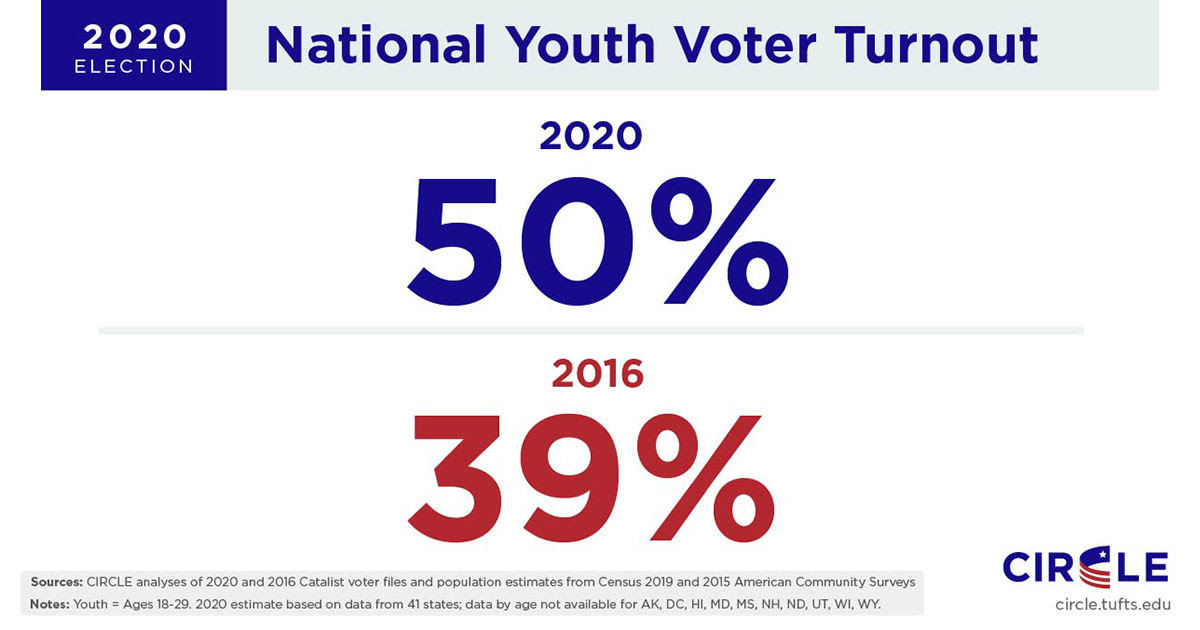
CENTER FOR INFORMATION & RESEARCH ON CIVIC LEARNING AND ENGAGEMENT
AROUND THE CIRCLE

New CIRCLE Study Confirms
Major Increase in Youth Voter Turnout
We estimate that half of young people, ages 18-29, voted in the 2020 presidential election, a remarkable 11-point increase from 2016 (39%) and likely one of the highest rates of youth electoral participation in decades. Our new estimate is based on newly available voter file data in 41 states. The full analysis includes an interactive map with state-by-state voter turnout data for ages 18-29 and 18-19.
Numerous interconnected factors shape youth turnout: competitiveness, campaign outreach, the composition of the youth population, and state voting laws that can either facilitate voting or pose barriers for youth. It is crucial to examine these and other factors that may be at play in order to expand the electorate.
Key findings include:
- Youth voter turnout rates varied widely across the country. New Jersey (67%), Minnesota (65%), and Colorado (63%) had the highest statewide youth turnout rates, while South Dakota (32%), Oklahoma (34%), and Arkansas (35%) had the lowest.
- Electoral laws and policies had an impact. In aggregate, states with four or more facilitative election laws and policies had 54% youth voter turnout; states with one to three of these policies had 43%. Youth turnout was also highest in states that automatically mailed ballots to voters.
- Turnout among new voters is still lagging. We estimate that voter turnout among 18- and 19-year-olds was 46%. The newest eligible voters usually participate at lower rates, which highlights the need for Growing Voters and ensuring youth are ready to participate before they turn 18.
The major increase in turnout is a testament to the tireless efforts of youth, advocates, educators, and organizers—but it’s also a reminder that it will take their concerted efforts to ensure that young people are prepared and encouraged to vote in 2022 and beyond.
Read the Full Analysis of National Youth Voter Turnout
Young People Created Media
to Uplift their Voices in 2020
In addition to being an important space for information sharing, youth media creation on social networks and other digital platforms can be a critical form of civic engagement and development. By studying young people’s media creation habits, we seek to improve understanding of how young people use online spaces, with the goal of strengthening the accessibility of information and media creation opportunities to more youth whose voices have been marginalized.
Based on our analysis of the CIRCLE post-election youth survey, we find:
- Nearly half (45%) of young people have engaged in one of three forms of media creation about social and political issues: creating content for submission, sharing their own experience, or creating visual media.
- Compared to their white and Asian peers, Black and Latino youth have higher rates of media creation and engagement
Read the Full Analysis of Youth Media Creation in 2020
Today: Civic Education in Elementary Classrooms
Join us this afternoon at 4pm ET for a special webinar: Seeing “Everyday Civicness” in our Elementary Social Studies Instruction. We’ll be sharing insights from our research of K-12 civics in Massachusetts, and offering practical strategies for educators based on the Educating for American Democracy Roadmap.
CIRCLE is Hiring a
Senior Researcher
We currently have an open position for a Senior Researcher. We’re looking for a strong quantitative researcher who is committed to supporting young people and cvic engageent, and who can lead secondary data-analysis, large dataset creation/analysis, literature reviews, field experiments, and development of original surveys.
Connect with CIRCLE
Twitter | Facebook | Website | Email
CIRCLE is part of the Jonathan M. Tisch College of Civic Life

Copyright © 2021 Center for Information & Research on Civic Learning and Engagement, All rights reserved.

